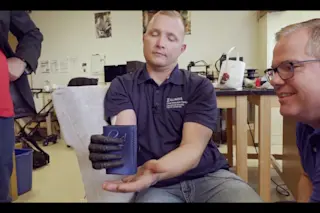HIGH-PERFORMANCE TIRES
They still look the way they’ve always looked—round and black. But they’re so much better now that they can be driven continuously at speeds up to 186 miles per hour and can handle as much as 50 percent more lateral force before slip-sliding away.
rubber
Ultrahigh-performance tires like Bridgestone’s new Potenza S-03 Pole Position aren’t made of sap from the rubber tree (Hevea brasiliensis) anymore. They’re completely synthetic, based on petroleum polymers. The S-03 is built with about 30 chemicals, including carbon and sulfur. Fifteen different rubberlike compounds are precisely positioned throughout the tire, each having a different function. One compound in the sidewall, for instance, protects tires from ozone and sunlight. W-rated (168 mph) and Y-rated (186 mph) tires designed for summer driving are compounded to function best at a temperature of about 150 degrees Fahrenheit.
plies These layers of cord or wire are embedded in rubberlike ...














